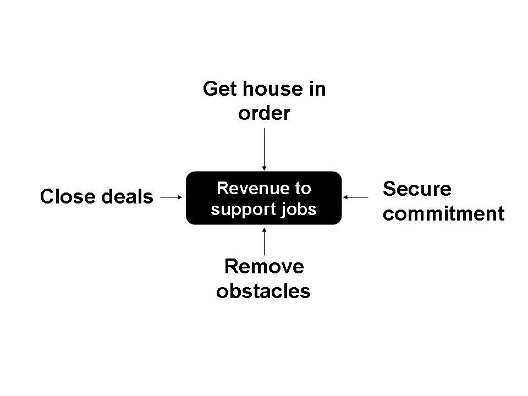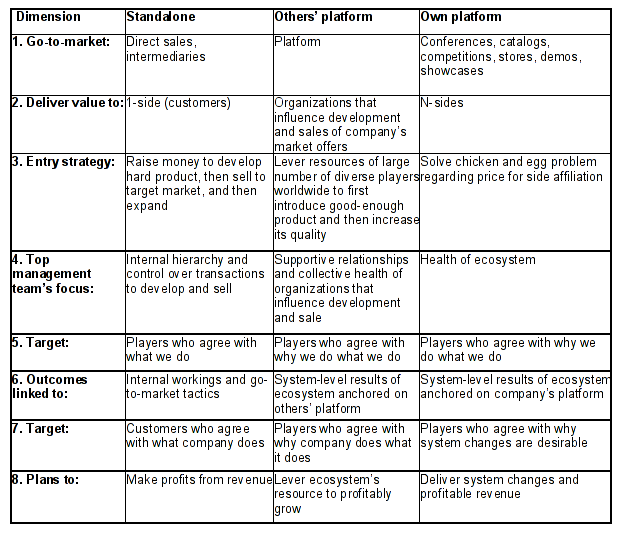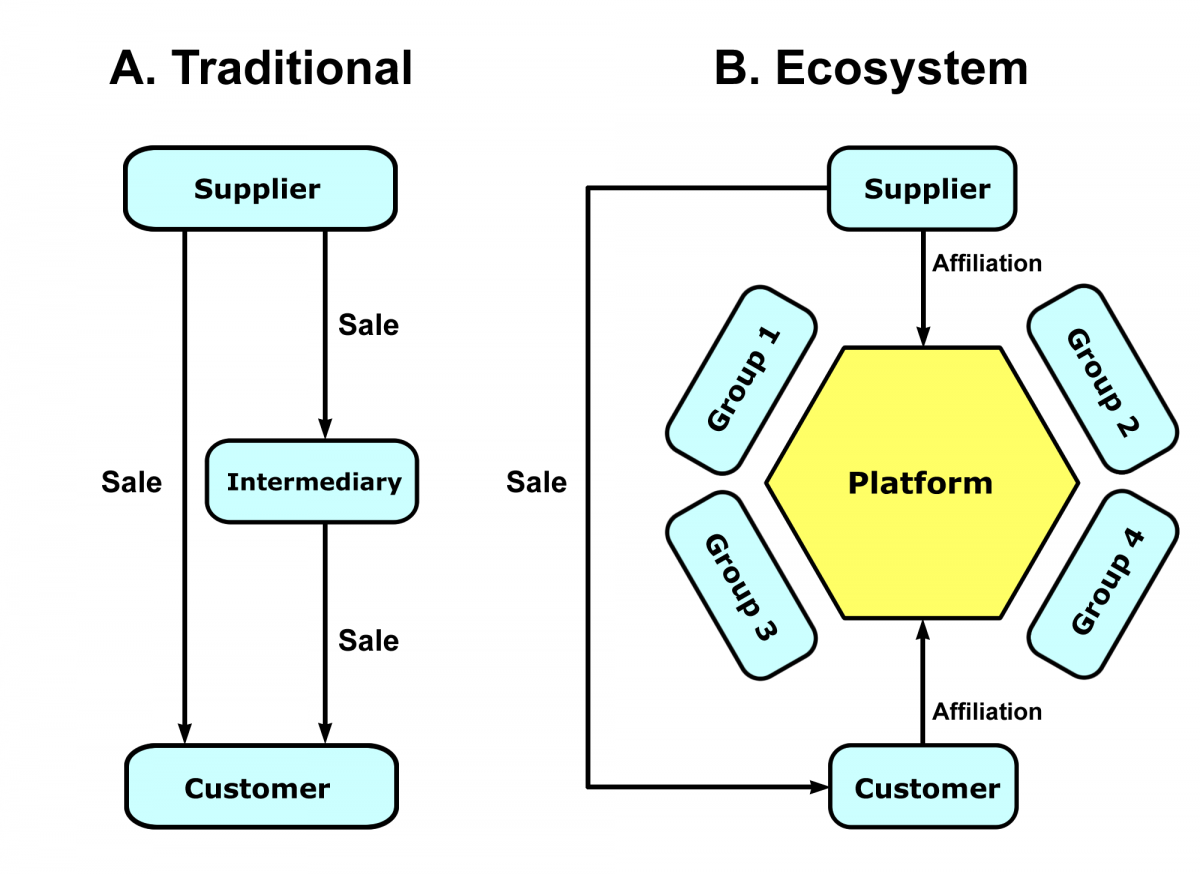"Revenue is all you need."
Pat DiPietro, VenGrowth Capital Partners Inc.
This article examines a new approach to grow the revenue of small technology companies and technology startups. We name this new approach the business ecosystem approach.
The blueprint, growth formulas, and business ecosystem approach examined in this article are being developed by the faculty and graduate students at Carleton University's Technology Innovation Management program.
The goal of the business ecosystem approach is to help:
-
small technology companies grow their revenue with the same discipline that they use to control their costs
-
economic development organizations create an environment that attracts and retains technology jobs and investment in Canada's Capital Region
-
develop the skills graduate students require to contribute to the new knowledge economy
The article is organized into five sections. The first section provides a blueprint to grow revenue and an inventory of growth formulas that top management teams of small technology companies and founders of startups find useful. The second section briefly defines business ecosystems, keystones and platforms. The third section describes the business ecosystem approach to grow the revenue of small technology companies and technology startups. It compares the traditional and business ecosystem approaches to growing revenue; identifies when the business ecosystem approach works better than the traditional approach; explains what small companies and startups need to do to grow revenue using the business ecosystem approach; and describes the benefits and risks of implementing the business ecosystem approach. The fourth section compares three approaches to growing revenue and highlights the differences between i) business ecosystems and development communities and ii) the business ecosystem approach and outsourcing. The fifth section identifies the key decisions a small technology company or technology startup needs to make to become the keystone that anchors a business ecosystem.
Blueprint to Grow
Figure 1 provides a blueprint of the actions needed to grow company revenue.
Figure 1: Blueprint to Grow Revenue

To get the house in order, the top management team of a small technology company or the founders of a startup must first:
-
raise the bar for performance
-
divest what adds no value
-
put legal, cash, intellectual property and personal affairs in order
-
act based on facts
To secure stakeholders' commitment, the company needs to:
-
create mind share around their products or services and the unique reason "why" the company does what it does
-
align with those who share their view of the broader market opportunity and flawlessly execute the plan that creates value from that alignment
-
simplify its products, services and solutions to make them hassle free for customers and channel partners
-
continuously improve its operations
To close deals, the company has to:
-
articulate and deliver what matters to customers and channel partners so they can in turn deliver their wins
-
develop differentiators for which customers are willing to pay
-
select the right competitors
-
quickly incorporate customers' changes into their market offers
To remove obstacles, the top management team of a small technology company needs to address four critical impediments to growth: i) lack of funding; ii) lack of skills; iii) lack of time; and iv) lack of access to customers and channel partners.
Growth Formulas
A growth formula is any behaviour that makes a company money and is lodged in the company's experience. It provides a focus that ties and aligns internal and external individuals. A growth formula makes it easier for company employees to make decisions that grow revenue. It provides strategic clarity, reduces complexity, increases learning and makes new employees productive faster.
Small companies that are part of the same business ecosystems may use various growth formulas. However, the growth formulas that small technology companies use are different from those used by larger, more established companies. A small technology company or a technology startup should identify and execute an appropriate growth formula. Common growth formulas used by small technology companies include:
-
help strong customers grow their business
-
bring innovation to market that is a complementary offer to a stronger player's offer
-
apply good technology developed by others to novel market opportunities
-
sell services to a market niche first and then develop and sell products or solutions
-
demonstrate that an offer works, sell to first customers, and identify the profitable business model that achieves the price first customers are willing to pay
-
demonstrate that offers provide value to users, economic benefits to customers, and can be delivered at a profit
-
make competition irrelevant by concurrently delivering twice the value at half the cost
-
sell to a specific narrow niche, cross-sell markets, then fill higher order needs
-
sell to customers in mature markets abandoned by incumbents
-
fill gaps that occur when customers must migrate from an old to a new system or technology
-
resell services in geographies that are too expensive for other service providers
Business Ecosystems, Keystones, Member Classes, and Platforms
A business ecosystem is a community of companies, organizations and individuals that:
-
share a desire for achieving high-impact, system-level results
-
deliver benefit to their customers, partners and community members from their interactions using a multi-sided platform
-
contribute to maintaining the health of their community
A keystone is the community member that owns, operates, and evolves the platform. The two main responsibilities of the keystone are to increase the: i) volume of transactions among members; and ii) efficiency of new product or service creation.
To fulfill its two key responsibilities, the keystone:
-
provides vision, leadership and governance
-
defines the member classes and the price structure for membership in each class
-
sets the prices for transactions among members
-
maintains the ecosystem's health via knowledge transfer, market outreach, and other activities
-
recruits members, builds audience and extends reach
-
sets the intellectual property regime
-
provides information members value but can't find on their own
-
creates new spaces in the ecosystem where self organizing action groups can perform distinct functions that address needs and add value to the overall ecosystem
Community members can be organized into member classes based on the value they derive from the platform. For example, a three-sided platform can anchor a community comprised of three member classes: job seekers, job providers and advertisers. Each side of the platform delivers value to a specific member class.
The platform is a product, process, location, service or technology that delivers value to two or more member classes. It anchors the ecosystem. The platform is more than a focal point, such as a technology standard, in that it increases a member's access to members in the other classes and reduces search and transaction costs for all members.
The value of the platform to a member increases with the number of members in the other classes. For example, the value of the platform to a job seeker increases in proportion to the number of job providers and advertisers.
Business Ecosystem Approach
We argue that the actions required to grow a company's revenue and to implement growth formulas can greatly benefit from embracing the business ecosystem approach.
Figure 2 illustrates the difference between the traditional approach and the business ecosystem approach to grow revenue.
Figure 2: Traditional vs. Business Ecosystem Approaches to Grow Revenue
The traditional approach entails pushing the products, services and solutions developed by a supplier to customers either directly or through intermediaries. The direct sale is analogous to a suitor endlessly knocking at doors and asking "Here is my customer value proposition, will you marry me?" The sale via intermediaries is analogous to the same suitor paying various friends to knock at more doors on the suitor's behalf.
In the ecosystem approach, the supplier uses a multi-sided platform to interact with customers and members of different groups such as complementors, investors, and community leaders to develop and market its offers. The platform, shown as a hexagon in Figure 2, acts like a magnet that attracts the organizations a small company needs to develop and market its products. It is analogous to the young suitor attending a large and never ending party organized for the sole purpose of finding a suitable mate. The party is attended by others wishing to marry, bankers, home and car sellers, magistrates who can solemnize marriages, and so on.
There are five key takeways from this model. First, in the traditional approach the supplier needs to first develop a polished product or service to sell. In contrast, in the business ecosystem approach the supplier can introduce "good enough" products or services and then polish them by interacting with a large number of members of many different groups.
Second, in the traditional approach the supplier focuses on delivering compelling value to members of a single group: its target customers. In the business ecosystem approach the supplier delivers compelling value to members of different groups: its customers and all the organizations that help develop the product and bring it to market.
Third, in the traditional approach the supplier desires to attain company-level results such as sales targets. In the business ecosystem approach the supplier desires to achieve company- and community-level results. The supplier in an ecosystem shares with others the desire to achieve high-impact, system-level results.
Fourth, in the traditional approach the supplier is interested in maintaining its own company's health. In the business ecosystem approach the supplier is also interested in maintaining the health of the community anchored around the platform because it relies on this community to develop and market its products.
Fifth, the traditional model emphasizes development of a polished product followed by the transfer of what has been developed to the market. The business ecosystem approach focuses more on adoption than development.
In many respects, this can be seen as an agile approach to business creation. Small technology companies operating within an ecosystem deliver rapidly and incrementally using their particular growth formula.
When this Approach Works Best
The success of a business ecosystem approach depends on whether a company can generate more sustainable revenue as a member of the ecosystem than without such membership.
The business ecosystem approach is a more effective way to grow a small technology company's revenue when the market life of the product or service is short, the demand is uncertain, barriers to entry are low, the cost of volume production is low, and the competition is global. The business ecosystem approach is also effective when the supplier needs to:
-
reduce time to cash
-
invest to improve product quality
-
develop a strong brand
-
access experts and specialized assets worldwide
Products introduced by a company levering a business ecosystem compete with products of companies that:
-
use the traditional approach to grow revenue
-
lever the same business ecosystem
-
lever different ecosystems
The business ecosystem approach to grow revenue requires that the small technology company interact with a large number of members in different parts of the total value chain using the keystone's platform in order to:
-
lever resources, talent and learning from other organizations
-
deliver value to all the organizations that influence the development and sale of its market offers
-
strengthen the product differentiators for which customers pay
-
co-create solutions, products and services
-
link to other business ecosystems
The company also needs to contribute to achieving the community's desired outcomes as well as compete for leadership positions at the governance, niche, and project levels.
A growth-seeking technology company can use the business ecosystem approach to offset its small size. Low cost company interactions with a greater number and more diverse set of customers, complementors, solutions providers, and suppliers results in:
-
a greater number of options to grow
-
more sustainable revenue streams
-
stronger product differentiation
-
greater visibility of early changes in economic conditions, customer tastes, and competitors
-
greater learning from others
-
greater access to shared infrastructures, specialized skills, resources, talent, supply chains and partnerships worldwide
-
higher quality feedback on company's operations
-
lower development and marketing costs
-
a greater ability to fill capability gaps
Contributions to achieving the community's desired outcomes results in greater company alignment with the actions of strong leaders in the community.
Leadership positions in the community results in a stronger brand and the ability to influence organizations upon which the company depends for the development and marketing of its offers.
Risks
A small technology company that uses a platform owned by another company is exposed to three major risks. First, the platform owner may:
-
increase the price of platform affiliation and/or price of transaction
-
act to vertically integrate the small company into its own business
-
weaken the small technology company's relationships with customers
-
appropriate a significant percentage of the value the small company helped to create
The second risk of using a platform operated by others is that stronger companies may become members of the ecosystem and choose to compete directly with the small technology company.
The third risk occurs when the company does not derive sufficient benefits from being a member of the platform to justify the costs associated with membership.
Making Comparisons
To grow revenue, a company can choose among three general approaches:
1. Operate in the traditional, standalone mode.
2. Be a player in somebody else's multi-sided platform.
3. Operate and evolve a multi-sided platform on its own or with others.
Approaches 2 and 3 entail the use of business ecosystems. Other approaches can combine these three general approaches, such as simultaneously being a player in somebody else's multi-sided platform while operating another platform.
Table 1 compares the three approaches to growing revenue in terms of eight dimensions.
Table 1: Comparing Three Approaches to Grow Revenue

A development community is not a business ecosystem, regardless of how active the development community is. A business ecosystem is much more than a development community that fosters wider use of, understanding of, or access to technology. In contrast, a business ecosystem provides a company access to cash and leadership as well as supporting a company in achieving a wide range of business goals. A business ecosystem rewards performance of multi-company collaboration, not developer collaboration.
The business ecosystem approach to growing revenue is not about outsourcing, regardless of how many resources a company levers from the external environment. The business ecosystem approach is more about growing sustainable revenue than reducing costs, which is the main purpose of outsourcing. The focus of the business ecosystem approach is to create new things that deliver value to customers and to all the organizations that contribute to the company's development and marketing initiatives. The focus of outsourcing is to produce existing products at lower costs. The business ecosystem approach requires that a company access skills dispersed globally and attract organizations to share its development, commercialization and marketing risks. Outsourcing requires the company to procure commodity assets. The business ecosystem approach helps a company build capabilities to differentiate offers for which customers pay, while outsourcing helps the company avoid investing in capabilities for which customers will not pay.
Platform Ownership
A company that wishes to own, operate and evolve a multi-sided platform needs to know the: i) main functions of the platform; ii) key design dimensions; and iii) benefits and risks of platform ownership.
As mentioned previously, the two main functions of the keystone are to increase the: i) volume of transactions among members; and ii) efficiency of new product creation. Seven design dimensions are used to deliver the two main functions of the platform:
1. Community outcomes: the desired high-impact, system-level results that motivate players to affiliate with the platform and will be used to brand the ecosystem.
2. Health metrics: the indicators, end-points, and parameters that will be used to assess the platform's ability to maintain its function and structure.
3. Number of member classes: represents the number of sides that the platform should have.
4. Number of members for each class: refers to the maximum number of members in each class. This decision affects the intensity of competition for each member class.
5. Platform type: the product, process, location, service or technology selected to deliver benefits to the members of the different classes.
6. Price structure: prices paid by members to affiliate with the platform and transact with other members.
7. Governance: the system used to control the operations and evolution of the platform. It includes the number of directors that should represent each member class in the Board of Directors of the keystone.
The main benefits of owning, operating and evolving a platform are: i) greater profitable revenue; ii) superior information; and iii) greater market power.
The main risks of owning a platform are four. First, there is a risk to the platform owner that organizations develop a way to benefit from interacting with each other without paying to become members of the platform. If organizations do not pay to be affiliated with the platform, the revenue to the company that owns the platform will decrease. The second risk is that revenues from platform affiliation and members transactions do not cover operating costs. The third risk is that the platform fails to scale its operations and it can't grow fast enough to meet demand. The fourth risk is that a superior keystone becomes a direct competitor.
Conclusion
This article adds a new approach to grow revenue that is useful to small technology companies and technology startups. Capability to generate revenue is important to both companies and regional economic development organizations because it secures well paying jobs.
Business ecosystems can accelerate revenue growth only if the company has a solid base to grow on. The blueprint shown in Figure 1 and the inventory of growth formulas provide this base.

